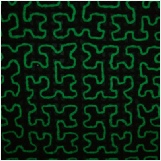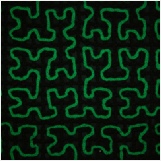

Click to read general information about afghans

©Woolly Thoughts 2018 Contact Us
Buy the pattern on the Order Form
or


Buy a pattern
for this afghan
on the order form
 Buy now
Buy now



SPACECRAFT
A representation of a ‘space-
This is a Hilbert Open Peano Curve (You can tell it’s ‘open’ because the curve comes in at one side and goes out at the other, having visited every square.)
Theoretically these curves cover every point on the surface until nothing is left. This can be imagined in mathematical theory but does not work in real life.
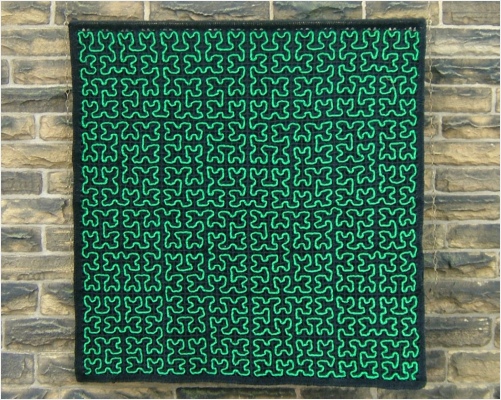

Scroll down for more information about
Spacecraft

RELATED DESIGNS
SPACE-
SPACE-

CONSTRUCTION INFORMATION
The background is worked as a filet crochet grid. It is important that the squares should be square. The pattern gives various ways to achieve that.
The curve is attached to the grid by surface crochet. It is an easy technique but needs a lot of concentration.

CROCHET INFORMATION
The background is an open grid. It appears solid because it is seen against a black backing.
This was our first afghan using a grid technique. In retrospect, the yarn for the curve could have been thicker and more prominent. The curve does not use a lot of yarn so could use up some exotic left-
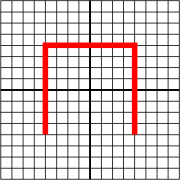
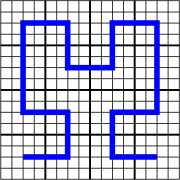
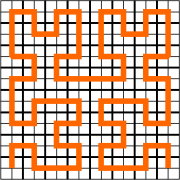
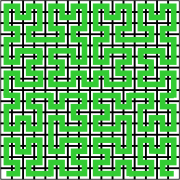
Spacecraft is on a 64 x 64 grid. The examples given here are on a 16 x 16 grid to show how the principle works.
Stage 4
The curve visits every square of the original grid.
In crochet, the curve becomes much more rounded at the corners.
Stage 1
Imagine the grid divided into four squares. The curve goes to the centre of each of those squares.
Stage 2
Each of the four large squares can be divided into four more squares. The curve passes through each of these squares, going in the same general direction as before.
Stage 3
The squares are subdivided into four again and this curve goes to each of the new squares.
On the day I visited the Science Museum to hand over Square Deal, Counting Pane and Pythagoras Tree, the Curator of Mathematics asked, ‘Can you knit a Peano Curve?’ I had no idea as I had never heard of a Peano Curve. She said she would let us have some information and a few days later we received a letter containing some pages photocopied from an academic tome. We studied it but decided it could not be done. We learned that a Peano Curve is a space filling curve and is rather like a fractal. It follows a simple path round a square but each section of it can be split up to reproduce that path on a smaller scale. Theoretically this happens again and again until the whole surface is completely covered. We couldn’t knit it but we kept the paperwork.
About two years later we went to visit Alec Dalglish of the Knitting Craft Group. We spent a whole afternoon with him on our way back from a Maths conference (probably the same one where Half Measures was designed) We sat in his office whilst he pulled out one treasure after another. Many of these were fantastic crochet pieces by artists such as Jan Messent, James Walters and Sylvia Cosh. In a sudden flash I realised that the idea we had been sitting on for so long could be represented in crochet -
The first difficulty was drawing the curve at the level of complexity to fill a grid about four feet square. Ben (who is also a mathematician/ scientist) came to the rescue and drew several superimposed curves, in different colours, until we reached the one we needed.
We opted for a black background with the brightest colour we could find for the curve itself -
Once the grid was made the curve had to be applied. It was very difficult to follow the drawing until we made use of the fact that the curve divides itself into square sections so only one part is needed at a time and the drawing could also be split as many times as necessary to make it clear. It was still difficult to twist and turn the afghan for each bend of the curve but this got easier with practice.
The complete afghan was very open so was mounted on a black background to make the curve more obvious. It was named Peano Beano.

Shortly after this we were asked to attend a Maths and Art conference at Oxford University but refused as we thought we would be out of our depth with such high powered people. We were told that there would be an exhibition space and that our latest creation would be welcomed. Eventually we agreed to go. We took Peano Beano (and a cuddly white teddy bear, dressed in a Möbius scarf and waistcoat, for moral support.)
Almost immediately we were informed that Peano does not rhyme with Beano, it should be pronounced peaarno. Even worse was the announcement, ‘That’s not a Peano curve!’ from one of the august mathematicians. We had believed the evidence of the tome from the Science Museum. We knew nothing else about this curve. We were out of our depth. How were we going to talk our way out of this?
We needn’t have worried. Within seconds there were voices on all sides arguing as to whether it was, or was not, a Peano curve, or whether it could be a Hilbert curve. All were trying to justify their answers. The argument went on for some time but there was no satisfactory outcome. The mathematicians were happy that we had provoked this discussion so we felt quite justified in being there.
Peano Beano had already been a major turning point because it broke away from our self-
We spent some time trying to solve the argument and eventually found the answer in a book by the American mathematician, Martin Gardner. They were all right! Peano Beano was a ‘Hilbert Open Peano Curve’. We decided it had to change its name so it became Spacecraft. We also discovered that there is such a thing as a ‘Sierpinski Closed Peano Curve’, which is sometimes called a square snowflake so we made that too and called it Square Snowflake.
Click to see
larger pictures
